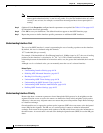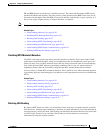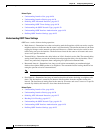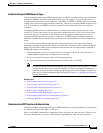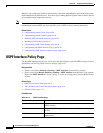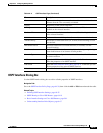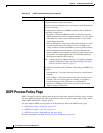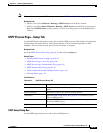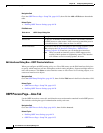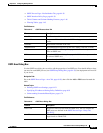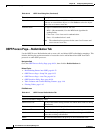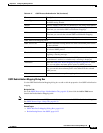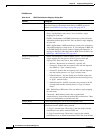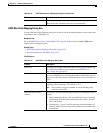
64-34
User Guide for Cisco Security Manager 4.4
OL-28826-01
Chapter 64 Configuring Routing Policies
OSPF Process Policy Page
OSPF Process Policy Page
OSPF is an interior gateway routing protocol that uses link states instead of distance vectors for path
selection. OSPF propagates link-state advertisements (LSAs) instead of routing table updates, which
enables OSPF networks to converge quickly.
You can configure OSPF process policies from the following tabs on the OSPF Process page:
• OSPF Process Page—Setup Tab, page 64-35
• OSPF Process Page—Area Tab, page 64-36
• OSPF Process Page—Redistribution Tab, page 64-38
For more information, see OSPF Routing on Cisco IOS Routers, page 64-19.
Configure Network Type When selected, enables you to select a network type that differs from
the default medium used by the interface.
When deselected, the network type is equivalent to the default medium
used by the interface.
For nonbroadcast multiaccess (NBMA) networks (such as ATM and
Frame Relay), options are:
• Broadcast—Treats the NBMA network as a broadcast network,
which eliminates the need to configure neighbors. Use this option
when there are virtual circuits from every router to every router
(fully meshed network).
• Point-to-Multipoint—Treats the nonbroadcast network as a series
of point-to-point links. This option is easier to configure, less
costly, and more reliable than NBMA or point-to-point networks.
• Point-to-Multipoint Non-Broadcast—Statically maintains the
known neighbors of the network. Selecting this option helps avoid
the problem of losing neighbors that were learned dynamically
through the reception of hello packets.
Note Another option for NBMA networks is to configure neighbors
manually using FlexConfigs. See Understanding FlexConfig
Policies and Policy Objects, page 7-2.
For broadcast networks (such as Ethernet, Token Ring, and FDDI), you
can select:
• Non-Broadcast—Treats the broadcast network as a nonbroadcast
network.
• Point-to-Point—Treats the broadcast network as a point-to-point
network. You can use this option, for example, to configure a
broadcast network (such as Ethernet) as a nonbroadcast
multiaccess (NBMA) network if not all routers in the network
support multicast addressing.
Table 64-12 OSPF Interface Dialog Box (Continued)
Element Description



